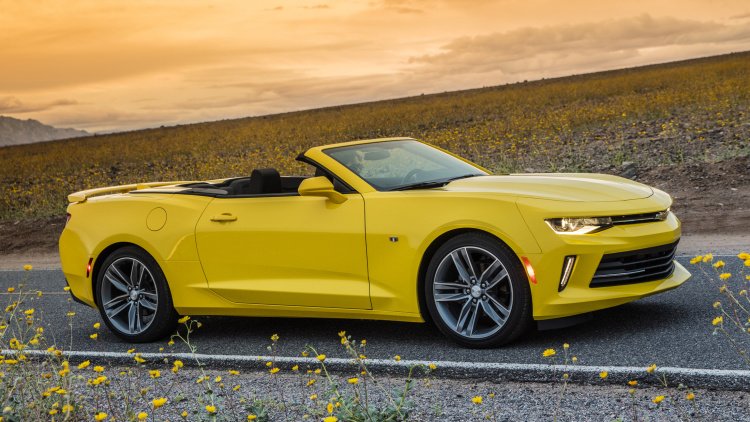2016 Chevrolet Camaro Convertible 2.0L Turbo Quick Spin

The 2016 Camaro offers a turbocharged inline four-cylinder engine rated at 275 horsepower and 295 pound-feet of torque. It will hustle to 60 miles per hour in 5.4 seconds, gets up to 31 miles per gallon on the highway, and in the words of chief engineer Al Oppenheiser, it's a "no-excuses" engine.
That's a cliché, but he's right. Driving the Camaro 2.0T is not something you need to apologize for as an enthusiast. The sports car has plenty of power, handles well, and it even sounds decent for a turbo four (okay, that's an excuse). It's a different kind of energy for the Camaro, and it underscores the car's transition from hefty American muscle to something more sinewy and sophisticated.
We tested the four-banger on the curvy street course at Spring Mountain in Nevada, and then navigated the dusty desert roads leading to Death Valley in California. We even hopped in a convertible, which like its hardtop sibling is better and more refined than before. Four cylinders are fine with the top down, too.
Driving Notes
- The 2.0-liter engine uses variable-valve timing and direct injection. Maximum torque comes on at 3,000 rpm, and you get more of it than you do when the 284-lb-ft V6 climaxes at 5,300 rpm. For enthusiasts, this is why you buy this car: the low-end torque. It makes the turbo Camaro feel more lively out of the gate than the V6, even though models with the larger engine are still quicker, getting to 60 mph in 5.1 seconds.
- The four-cylinder's get-up was evident on the track, especially with the six-speed manual transmission. We left the Camaro in third gear most of the time, and there was always plenty of grunt as we built speed coming out of corners. Upshifting on the brief straightaways, we wished for the higher output of the 335-hp V6. Or a V8.
- Speaking of the track, the four-cylinder model and its 3,339-pound curb weight (with the eight-speed automatic) is more than up for aggressive driving. We tossed it through the tight corners at Spring Mountain, let the tail come out a little bit, and enjoyed the lithe Camaro. We drove the new V6 model, which weighs 3,435 pounds with the automatic, around the Indycar circuit in Detroit and came away with similar impressions.
- The Camaro is in shape, there's no doubt about it. That's reflected in the steering, which feels more connected, and the suspension, which stays flat and controlled for longer (unless you want to skid through a corner or two). The brakes offer plenty of grab, bailing us out when we're a little late slowing at the end of a straight.
- You do have to live with the turbo sound. That's fine. It's not bad. Not as good as the V6 or V8, but what turbo four is? The Camaro starts out with a buzzy noise, then as it accelerates, the pitch evens out and it sounds better. You won't be embarrassed by it.
- Believe it or not, we did drive the Camaro 2.0T on public roads after reluctantly leaving Spring Mountain. It's plenty capable for passing when we dropped down a couple of gears and ventured across the dotted line to pickoff lethargic traffic. It's strong when pulling away from stoplights and will hum along smoothly at 70 mph around 2,000 rpm.
- So the turbo engine is the spotlight feature for enthusiasts, but we also briefly sampled the Camaro convertible during the road-test portion of our drive, which did have the I4, too. Our bright yellow tester blended with the wildflowers, which were blooming in Death Valley for the first time in nearly a decade. Once on the open road, we dropped the top. You can do that at up to 30 mph, and it works flawlessly. In fact, it flagged us when we crept up over 30. As native Michiganders, we found the roads are embarrassingly smooth in Nevada, so it was difficult to detect a huge difference in structural integrity compared to the coupe. The convertible was slightly looser, but we'll need to rattle over a few potholes to confirm that in greater detail.
- The ragtop now features an attractive hard tonneau cover that smoothes out the rear design aesthetic. It's clean and well-considered, and it makes the Camaro look much better with the top down. A new remote feature allows you crack the top off using the key fob, which is just kind of cool. We timed the operation. It opened for us in about 11 seconds and closed in 14 seconds, in line with Chevy's claims. The convertible also aids visibility. The gen six Camaro coupe is so hunkered down and the roof is so raked, it can be a challenge to see out of it. One solution: get a convertible.
- Regardless of your roof choice, the new I4 is a strong, energetic engine. It's something to consider as a fuel-economy option, though the overall gains are not spectacular (25 mpg combined for the I4 vs. 23 mpg combined for the V6). The EcoBoost I4 Mustang, which is slotted in the middle of Ford's pony car line, feels more potent, as its 310-hp rating would indicate.
The I4 engine is the entry point to the Camaro line. For $1,495 more you can get the 335-hp V6. The 60-hp difference is noticeable, as you would expect. The naturally aspirated engine sounds exponentially better. As much as we like the turbo four – and we really do – the V6 Camaro is where we'd spend our money.
